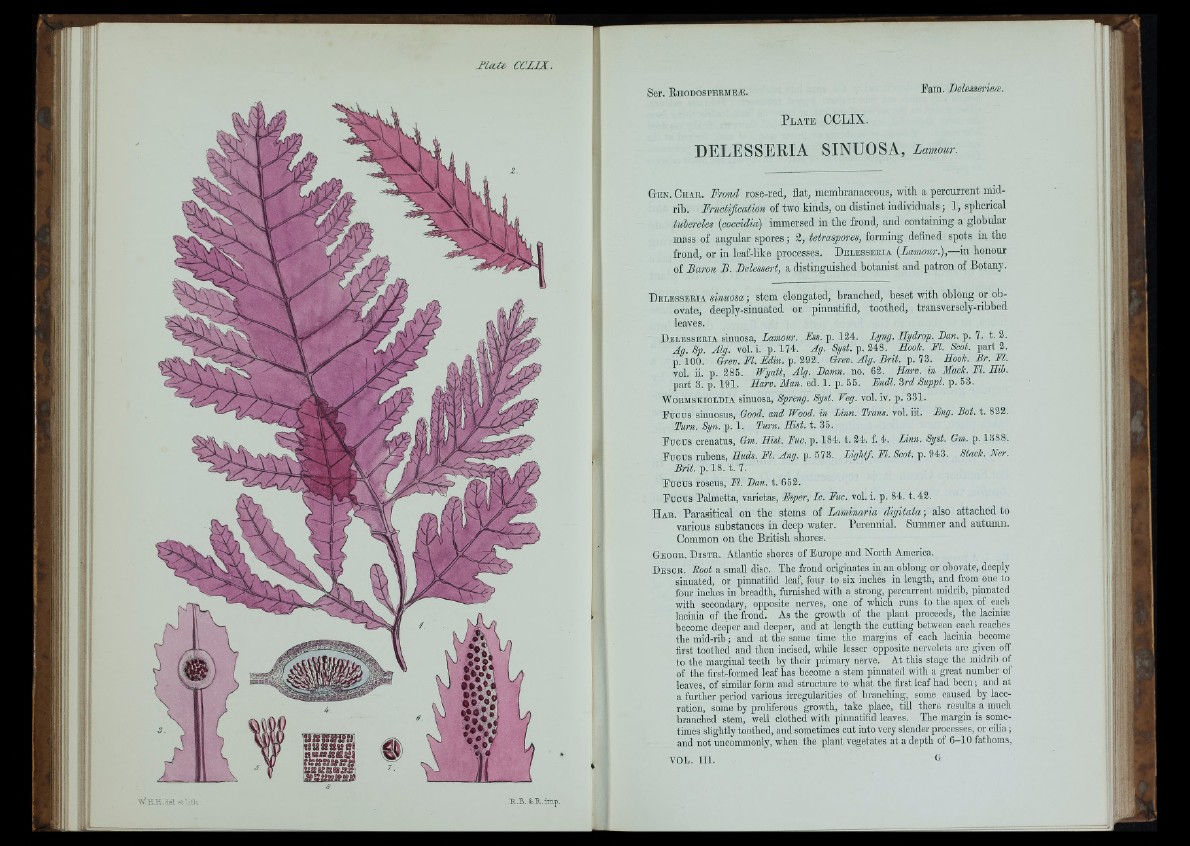
L i DELESSERIA SINUOSA, Lamour.
Gen. C h a e . Frond rose-red, flat, membranaceous, with a percurrent midrib.
Fructification of two kinds, on distinct individuals ; 1, spherical
tubercles (coccidia) immersed in the frond, and containing a globular
mass of a.Tign1ar spores ; 3, tetraspores, forming defined spots in the
frond, or in leaf-like processes. D e l e s s e e i a (Lamour.),—in honour
of Baron B . Delessert, a distinguished botanist and patron of Botany.
D e l e s s e e i a sinuosa-, stem elongated, branched, beset with oblong or obovate,
deeply-sinuated or pinnatifid, toothed, transversely-ribbed
leaves.
D e l e s s e e ia sinuosa, Lamour. Ess. p. 124. Lyng. Hydrop. Dan. p. 7. t. 2.
Ag. Sp. Alg. vol. i. p. 174. Ag. Syst. p. 248. LLooh. El. Scot. part 2.
p. 100. Grev. M. Edin. p. 292. Grev. Alg. Brit. p. 73. Hook. Br. El.
vol. ii. p. 285. Wyatt, Alg. Damn. no. 62. Harv. in Mack. El. Hib.
part 3. p. 191. J f « . ed. 1. p. 55. Endl. Zrd Suppl. p. hZ.
WOEMSKIOLDIA s in u o s a , Spreng. Syst. Veg. v o l. iv . p . 3 3 1 .
Pucus sinuosus. Good, and Wood, in lAnn. Tram. vol. iii. Eng. Bot. t. 822.
Turn. Syn. p. Turn. Hist. X.Z'a.
F ucu s creuatus, Gm. Hist. Eue. p. 184. t. 24. f. 4. TAnn. Syst. Gm. p. 1388.
Fuous rubens, Huds. El. Ang. p. 573. Light/. M. Scot. p. 943. Stack. Ner.
Brit. p. 18. t. 7.
Fucu s roseus, M. Dan. t. 652.
Fuous Palmetta, varietas, Esper, Ic. Fuc. vol. i. p. 84. t. 42.
H a b . Parasitical on the stems of Laminaria digitata ; also attached to
various substances in deep water. Perennial. Summer and autumn.
Common on the British shores.
G e o g e . D i s t e . Atlantic shores of Eui-ope and North America.
D e s c e . Boot a small disc. The frond originates in an oblong or obovate, deeply
sinuated, or pinnatifid leaf, four to six inches in length, and from one to
four inches in breadth, furnished with a strong, percurrent midrib, pinnated
with secondary, opposite nerves, one of which runs to the apex of each
lacinia of the frond. As the growth of the plant proceeds, the laciniæ
become deeper and deeper, and at length the cutting between each reaches
the mid-rib ; and at the same time the margins of each lacinia become
first toothed and then incised, while lesser opposite nervelets are given off
to the marginal teeth by their primary nerve. At this stage the midrib of
of the first-formed leaf has become a stem pinnated with a great number of
leaves, of similar form and structure to what the first leaf had been ; and at
a further period various irregularities of branching, some caused by laceration,
some by proliferous growth, take place, tiU there results a much
branched stem, well clothed with pinnatifid leaves. The margin is sometimes
slightly toothed, and sometimes cut into very slender processes, or cilia ;
and not uncommonly, when the plant vegetates at a depth of 6-1Ü fatlioms,
VOL. I I I . <■
WiH.H.ael B-.B.&H.imp.